Star Wars: The Old Republic Updated Hands-On - The Jedi Consular and Multiplayer Flashpoints
We wield the mystical powers of the Jedi consular and take on an explosive group adventure in this upcoming massively multiplayer game that takes place in the same universe as Star Wars: Knights of the Old Republic.
A long time ago in a galaxy far, far away, role-playing game developer BioWare announced it would create a massively multiplayer online role-playing game--a game that would take place not in the well-known universe of the original Star Wars motion picture, but rather in the pre-Star Wars universe that the studio had crafted for its highly acclaimed 2003 game, Knights of the Old Republic. Over time, we've had the opportunity to play and see more of The Old Republic, and most recently, we had the opportunity to play as the game's Force-sensitive characters. Wielders of the dark side of the Force can play as the Sith Warrior or the Sith Inquisitor, which we've covered previously--but this time around, we had a chance to join the light side playing as a Jedi character.
Why Are Video Game Adaptations Good Now? | Spot On Fallout 4 Next Gen Update Comparison Fallout 4 Steam Deck Verified Gameplay ALIEN: Rogue Incursion - Announcement Teaser Trailer Stellar Blade - 13 Things I Wish I Knew S.T.A.L.K.E.R. 2: Heart of Chornobyl — Official "Not a Paradise" Trailer Manor Lords - Official Medieval City Builder/RTS Launch Trailer Honkai: Star Rail - "Then Wake to Weep" | Version 2.2 Trailer Devil May Cry: Peak Of Combat | Dante: Blazing Tempest Gameplay Trailer SAND LAND — Official Launch Trailer Sea of Thieves Season 12: Official Content Update Video Stellar Blade - Hard Mode No Damage Gigas Boss Gameplay
Please enter your date of birth to view this video
By clicking 'enter', you agree to GameSpot's
Terms of Use and Privacy Policy
The Old Republic will have two different Jedi classes, the knight (a profession that focuses primarily on fighting while wielding a lightsaber, much like the guardian profession in Knights of the Old Republic) and the consular (a profession that focuses more on using mystical Force powers--again, much like in Knights of the Old Republic). We were given the choice to play as one of the two Jedi professions, and after seeing the intriguing 2010 Electronic Entertainment Expo trailer that shows the mystical powers of the consular, our choice was obvious. We hunkered down in front of a computer station at a recent press event and started playing as a brand-new Jedi apprentice--after sitting through a brief presentation on some of the other content planned for the game. Please be advised that we played a pre-alpha version of the game, so everything in this report is subject to change, and please also be advised that this story contains minor plot spoilers about the early experience.
The BioWare staff kicked off the presentation with a review of the recently revealed crew skills system, which lets you use your computer-controlled companion characters to more or less do your dirty work. This includes all the "go run around and do this for a while" activities you'd normally handle yourself in an online game, such as crafting (in this case, using the artifice or biochem skills), gathering crafting materials (in this case, bioanalysis and slicing--the game's term for computer hacking), and lower-level mission tasks (in the case of The Old Republic, this will mean diplomacy missions and treasure hunts). The idea is that your character is a true hero, and like any good hero, you have people who do that stuff for you. Since all characters in The Old Republic can have their own starship, which acts as a base of operations, your companions will hang out on your ship until you deploy them or put them to work on board at a crafting station. And you'll apparently be able to deploy as many as five different companion characters at once to do one thing or another for you, and they'll even continue working on their assigned projects after you log your character out of the game, meaning they'll continue toiling away and may have good news for you by the time you get back.
In addition to going over the crew skills system, BioWare staffers recapped the game's first warzone--a player-versus-player (PVP) area where Empire characters will be able to duel against Republic characters. (For the time being, BioWare has revealed PVP only for Empire versus Republic--there's no word on how or when players on the same factional side will be able to duel each other or if they ever will be able to.) Warzone PVP will take place via a handy queuing system you may have seen in other, similar games--you can reserve a spot in line and go on about your business taking on quests or fighting monsters, and once your number is up, you'll automatically be transported to the warzone for battle.
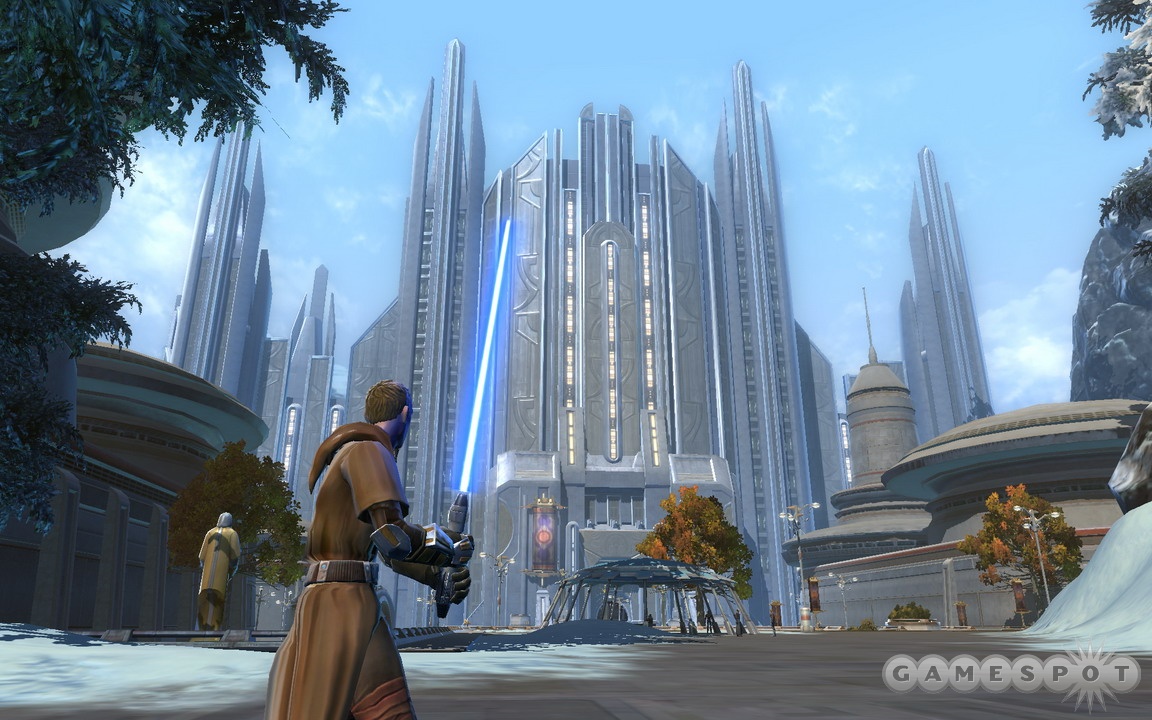
The warzone on display took place on the doomed planet of Alderaan (the development team intends for warzones to have story-based objectives that could have been "scenes out of one of the movies"). The Alderaan warzone pits one attacking team against a defending team that must prevent the enemy from destroying antiair turrets that will shoot down a gigantic airborne battleship. Should you fall in a warzone, you'll respawn in dramatic fashion, leaping onto a smaller ship and dodging through incoming flak while surveying the battlefield in real time to see how each team is doing before landing on terra firma--this brief scene will effectively be your character's "respawn timer" and is intended to be a lot more exciting and useful than just staring at a bar onscreen. Warzone PVP will earn you tokens--items that can be exchanged for special PVP-only gear. While you won't necessarily be able to join PVP battles right out of the gate, warzone PVP is intended to be a "viable alternative" to playing through the game's standard content, and just like the game's space exploration content (which has not yet been revealed), warzone PVP will net your character actual experience points that can be used to gain new levels.
With the presentation out of the way, we were free to dive into our hands-on time with the consular, which begins its career on the planet of Tython, a planet that will, in the grand scheme of The Old Republic's story, act as the first Republic "flashpoint"--an action-packed area that will be a stage for events that drive your character's primary story arc forward. Our consular character began her career at the Jedi sanctuary, reporting to a worried Jedi attendant who pointed out that our character's master wasn't currently available--she had apparently gone to a dig site. Tython is a planet that contains many ancient Jedi relics, including data-containing holocrons that may or may not house equally ancient Jedi secrets.
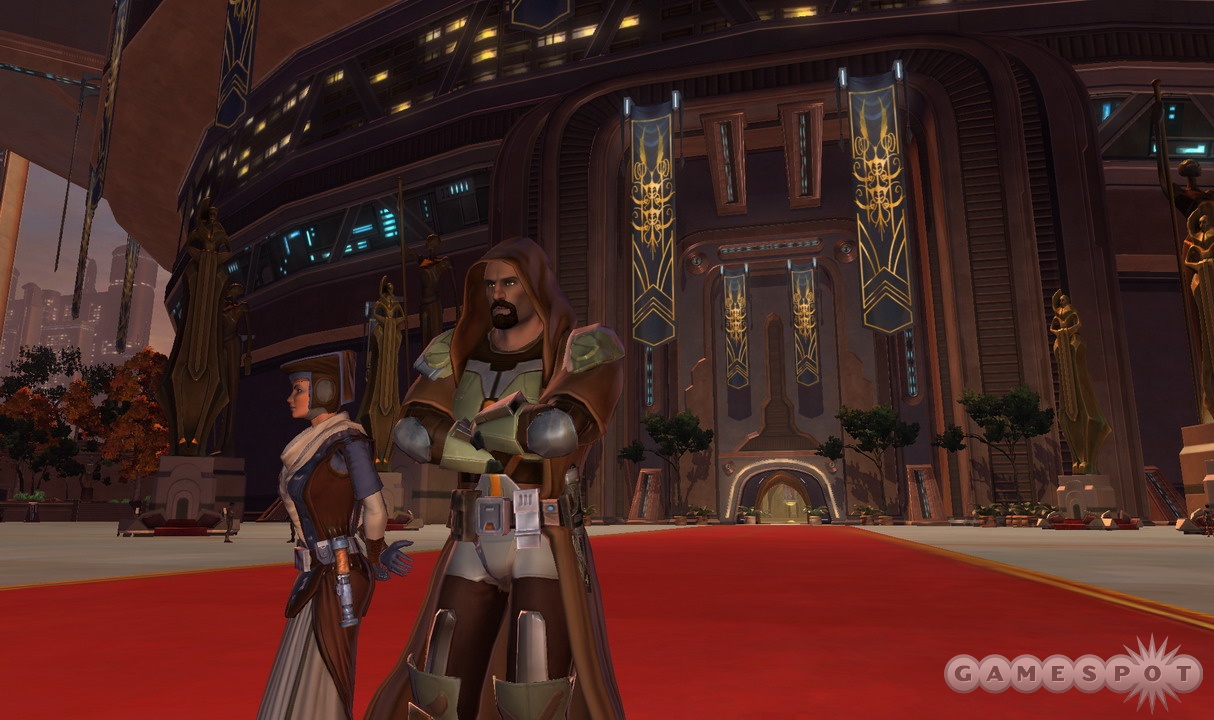
Unfortunately, the Jedi camp had come under attack by flesh raiders--bulgy, angry, cannibalistic humanoids who have not only looted holocrons, but have taken padawans from the academy as prisoners. We should point out that, as we've mentioned in our previous coverage, The Old Republic has plenty of different conversations with key characters that can go in different ways depending on how you decide to respond. In this session, we decided to play as a nice, good, good, nice, really nice Jedi who gave the kindest, gentlest, and possibly wimpiest dialogue answers possible in the hopes of earning as many light side points as possible. Like Knights of the Old Republic, The Old Republic has an alignment system that shifts your character between light side and dark side depending on your choices.
Our first official act as a Jedi consular was to hop onto a speeder--the game's terrestrial fast-travel system, which lifts you up in the air on a state-of-the-art speeder bike and whisks you away to your destination (not unlike a certain other eagle-headed bird that does something similar in a certain other online game). We headed out to the next outpost in the wilderness to rendezvous with our master and to rescue some holocrons and/or fellow padawans. We met with our master, a liberal sort who, surprisingly, associated with a hunter of the savage Trandoshan race (the same reptilian race as the bounty hunter Bossk from The Empire Strikes Back), and we received our first mission: to retrieve a missing set of ancient holocrons that belonged to some of the earliest Jedi--one of which belonged to the very first fallen Jedi who went on to found the evil Sith order. We wasted no time heading out into the field to seek the holocrons from the lush, arboreal forest clearing where they were last seen, and in the process, we did battle with a great many flesh raiders, who live a tribal lifestyle and use crude firearms and melee weapons in battle. Fortunately, in addition to our lightsaber, our consular wielded many powerful abilities to aid her in battle.
As we've reported previously, The Old Republic organizes your character's abilities in a hotkey bank tied to the number keys on your keyboard. Since the consular focuses less on melee attacks and more on Force power, the character seems to rely more strongly on its Force power meter, which becomes spent with each Force power used, similar to the mana bar in other fantasy-themed online games you may have played. Your most basic attack as a consular is the "saber strike," a melee attack that causes your character to strike the enemy with his or her melee weapon three times (Jedi characters don't start their careers with lightsabers--that comes later). Brand-new characters also start with the "project" ability--the power to telekinetically lift a chunk of rock from the earth below and hurl it at an enemy, dealing damage and potentially stunning the enemy briefly--and the "Force valor" ability, which, just like in Knights of the Old Republic, increases the target's resistance to various types of damage for the duration of the ability. New Jedi characters also have the "meditation" ability, which lets your character quickly regenerate lost health and spent Force power.
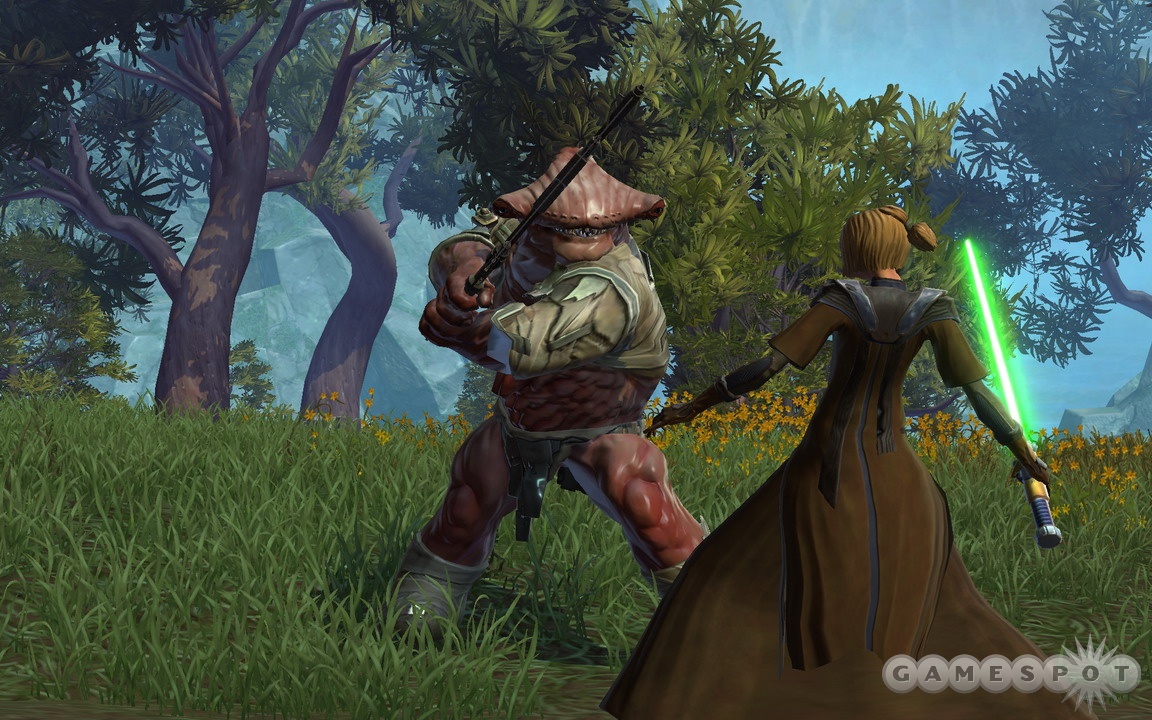
Once characters reach higher levels, they unlock new powers and abilities that must be purchased from a trainer character (the current version of the game also requires a small payment of credits, The Old Republic's in-game currency). At level 2, consulars may learn the "telekinetic throw" power, which lets the character mystically raise shards of earth and pelt the enemy with a continuous stream, dealing damage over time until the power runs out. At level 3, consulars can learn the "Force wave" ability, a powerful skill that takes place in a circular area of effect around the character and deals damage to any enemies in range and also knocks them clean off their feet. At level 5, our character was able to learn the more-powerful "rank 2" version of the project skill, as well as the "stasis field" ability, which--just like in Knights of the Old Republic--temporarily paralyzes an enemy, removing it from battle as a way to control crowds of foes. Interestingly, any enemy trapped in a stasis field in The Old Republic also takes double damage from the project ability. At level 6, your consular can learn the more-powerful "rank 2" version of the telekinetic throw power, as well as the new "Force potency" skill, a passive improvement that, until it expires, gives your consular the chance for any other Force power you use to have a "critical" effect, such that any damage-based abilities deal an extra 60 percent damage, and any healing abilities grant an additional 60 percent healing. (Again, we played an early version of the game, and all this information is subject to change.)
As we continued our quest, we found three of the four ancient Jedi masters' holocrons, only to discover that the fourth--the one that belonged to the first Sith--had somehow coincidentally gone missing. Our initial quest, which seemed like a straightforward archeological mission, soon became much more complicated, since the trail to the artifact led us to seek out the ancient hilt of a weapon that was the precursor to the first lightsaber...and to a potential hidden colony of Sith. The fact that this simple-seeming quest quickly becomes a nuanced quest that involves decisions of questionable morality and shades of gray shouldn't be surprising, given BioWare's pedigree of trying to weave story and complex characterization into its games.
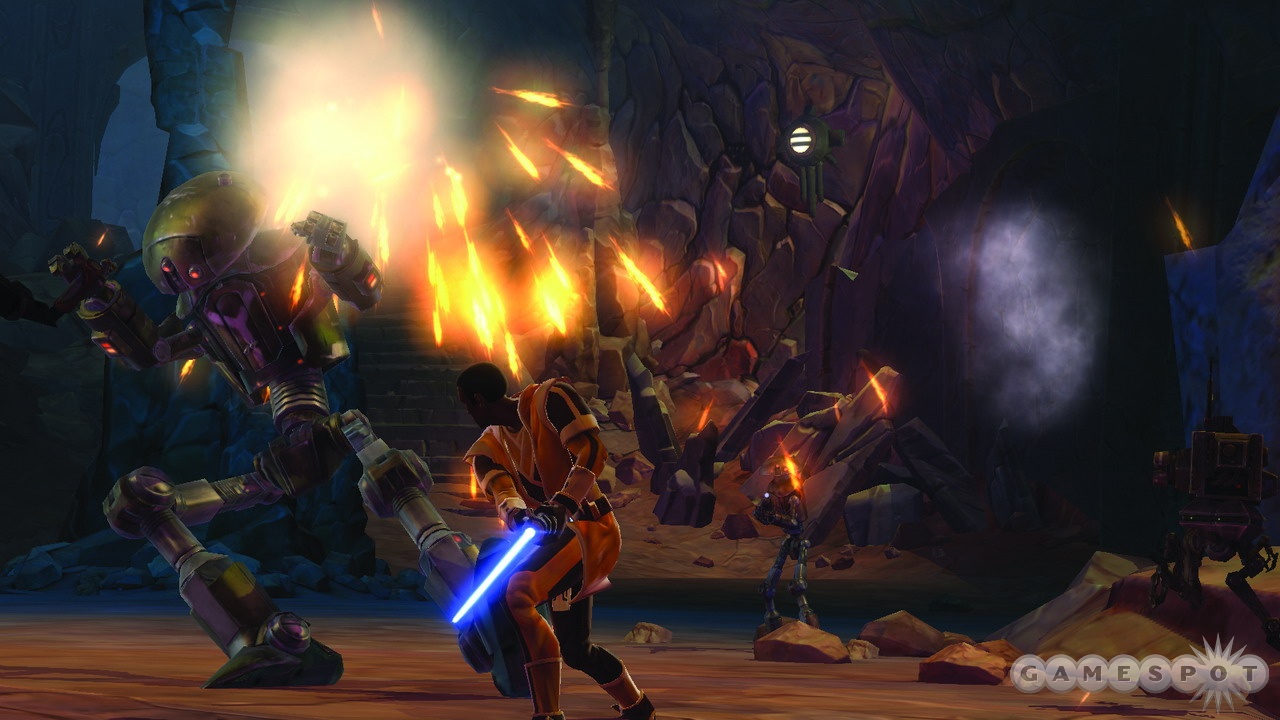
On our quest for artifacts, we encountered an illegal colony of Twi'leks--the Star Wars universe's tentacle-headed humanoids (the same race to which Return of the Jedi's Bib Fortuna belonged)--who were missing their village protector, a reclusive Twi'lek wilderness expert who had apparently discovered the most ancient secrets of the Sith and nearly killed us by collapsing his remote cave home down onto our heads. We tracked him down to a hidden Sith shrine inhabited by Sith disciples and were challenged to take massive damage and movement penalties in exchange for the health and safety of civilians imprisoned there. Because we were playing a goody-two-shoes character, we always opted to suffer whatever painful penalty was offered in dialogue to spare the civilians' lives until we reached the tomb of the fallen Jedi, at which point our time with the consular's initial quests ended.
Fortunately, that wasn't the end of our play session. We returned later to jump back into the game with our consular, which LucasArts staff advanced to level 10 so that the character had all the powers we've described previously, plus the ability to heal herself and others. We took this character into the flashpoint, one of the game's action-packed set-piece sequences, which often require lots of challenging battles and careful decision-making when participating in the game's group dialogue system--a system that engages your entire party in a key conversation with story-critical characters. All players in a party can participate in dialogue, but only one player's dialogue option can "win" each branch of dialogue with those characters--for instance, when confronted with a character who is withholding information from you and your buddies, you may choose to try to be threatening, while one of your friends might instead try to gently coax the information out of your contact. Exactly which character ends up speaking for the part at that juncture is determined by various modifiers (such as different characters' ability scores, alignment, and other variables).
This particular flashpoint took place shortly after our Jedi consular character would have completed her quests, acquired her lightsaber, and left Tython on a neutral starship. We and our Republic buddies were on our way to deep space when our ship was intercepted by Imperial troopers who demanded that our ship's captain surrender a Republic spy who was in the business of traveling to different worlds to convert them to the Republic's cause. After a terse conversation with the ship's security force, which was led by an Admiral Ackbar-esque Mon Calamari sergeant, our party was immediately attacked by waves of aggressive Sith and Imperial troopers that attacked us ferociously. Though we had continued to play as our Jedi consular character, our party members included a smuggler (the Republic's cover-based shooting class) and a trooper (the Republic's heavy weapons expert), both of which had strong offensive capabilities and neither of which had much in the way of support powers, at least at level 10. In addition, each of us had one computer-controlled companion that could be summoned to aid in battle--in our case, we had the help of the Trandoshan hunter who had befriended our master--a formidable melee combatant in his own right.
Since our team members were much better equipped for attacking, and perhaps not as well equipped for defense, we quickly abandoned any thoughts of using our damage-dealing Force powers and instead focused on our support powers, often opening up a fight with a new group of foes by rushing forward and triggering our Force wave power to send them sprawling and gain an initial advantage, and then retreating to the rear and focusing on either using stasis field to neutralize one enemy to help our team divide and conquer or using our healing ability to aid wounded comrades. This was an extremely early version of flashpoint gameplay that was in no way completely developed or balanced, and as a result, it ended up seeming extremely tough. At several points, one or more of our party fell in battle. Fortunately, any living character of any profession can instantly revive any other party member, so as long as at least one person stays alive, all hope isn't lost. This first flashpoint play session was primarily intended to be a proof-of-concept and a demonstration of how they'll work in the future. We're almost positive that this area will be retuned to keep it reasonably challenging but at a level that won't constantly wipe all of your party members out cleanly.
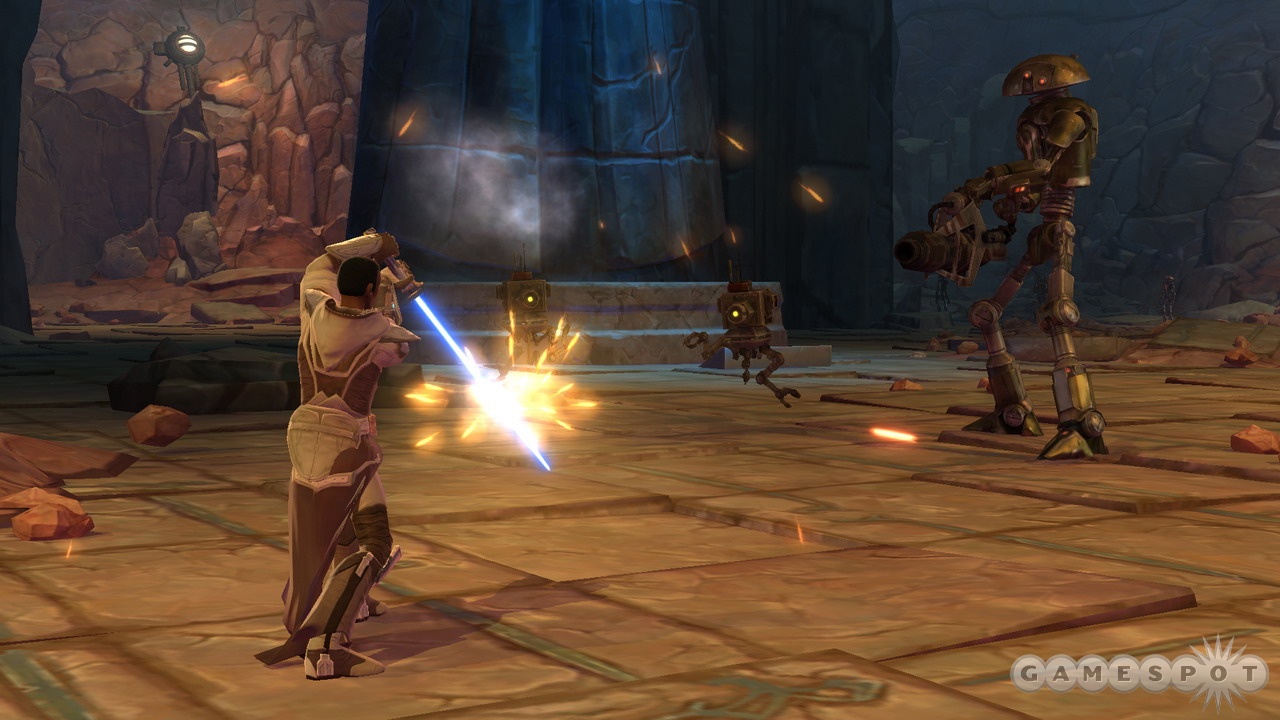
Having played some of the game's evil characters already, we found it hard to get excited about playing Jedi characters, since they don't have jetpacks and flamethrowers like bounty hunters and can't hurl lightning bolts like Sith. However, the Jedi consular character acquitted itself with honor and proved to be a very important profession with a lot of useful abilities that work well when adventuring alone, and work beautifully in a group. And now that we've had an opportunity to try out actual group play, we're even more intrigued by the prospect of playing the final game, which promises a deep story, group play, companions with their own skills, faction-based PVP, and space exploration. The Old Republic clearly intends to offer a whole lot when it eventually blasts off in 2011.
Got a news tip or want to contact us directly? Email news@gamespot.com
Join the conversation